八大常用句型
- 格式:doc
- 大小:67.00 KB
- 文档页数:12


英语的八种基本句型1.主语+谓语S+VShe never lies.他从不撒谎。
2.主语+谓语+宾语S+V+OHe brings an umbrella.他带来一把雨伞。
He has accepted our invitation.他已经接受了我们的邀请。
3.主语+连系动词+表语S+V+PHe is a student.他是一名学生。
They feel happy.他们感到高兴。
4.主语+谓语+间接宾语+直接宾语S+V+IO+DO My mother made me a beautiful dress.我妈妈给我做了一件漂亮的裙子。
She bought me a new bike.他给我买了一辆新自行车。
5.主语+谓语+宾语+宾语补足语S+V+O+C They painted the door blue.他们把门漆成了蓝色。
I find him a reliable man.我发现他是一个可信赖的人。
We saw him swimming in the river.我看见他正在河里游泳。
6.主语+谓语+状语S+V+AHe talked too much.他说的太多了。
Jim runs in the park.吉姆在公园里跑步。
7.主语+谓语+宾语+状语S+V+O+A He put the coffee on the table.他把咖啡放在桌上了。
I listened to her story carefully.我认真听了他的故事。
8.存在句( there be)There is a restaurant around the corner. 拐角处有一家餐馆。
There are two people waiting outside. 有两个人正在外面等候。
练习题: 判断下列句子的句式结构。
1. All of us laughed!2. I miss my grandma.3. Mr Zhou is a kind and humorous teacher.4. He told us a funny story.5. We must act.6. I had my first math class in senior high school.7. The math homework looks easy.8. I found most of my classmates friendly and helpful.9. My mom bought me a new dictionary.10. We had a chemistry in the newly built lab.答案:1.主+谓2.主+谓+宾3.主+系+表4.主谓+间接宾语+直接宾语5.主+谓6.主+谓+宾+状7.主+系+表8.主+谓+宾+宾补9.主+谓+间接宾语+直接宾语10.主+谓+宾+状。
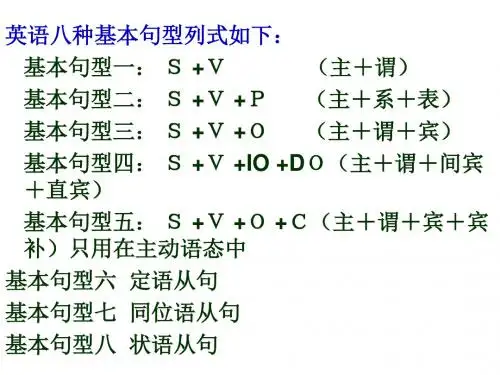
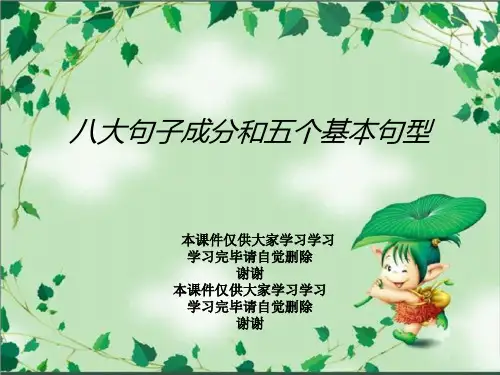
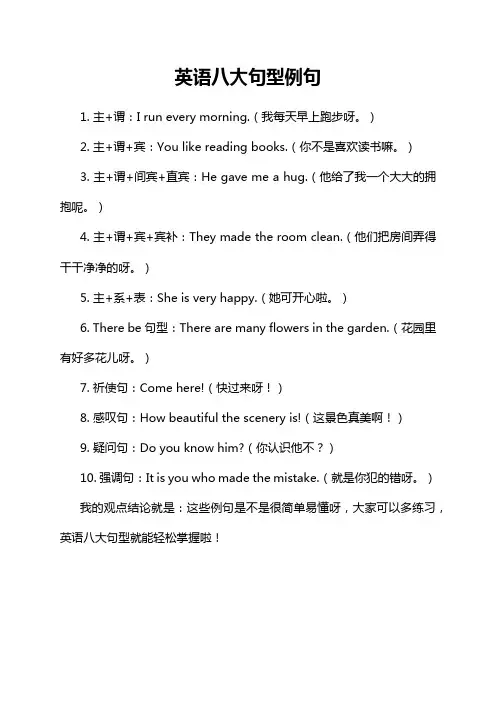
英语八大句型例句
1. 主+谓:I run every morning.(我每天早上跑步呀。
)
2. 主+谓+宾:You like reading books.(你不是喜欢读书嘛。
)
3. 主+谓+间宾+直宾:He gave me a hug.(他给了我一个大大的拥抱呢。
)
4. 主+谓+宾+宾补:They made the room clean.(他们把房间弄得干干净净的呀。
)
5. 主+系+表:She is very happy.(她可开心啦。
)
6. There be 句型:There are many flowers in the garden.(花园里有好多花儿呀。
)
7. 祈使句:Come here!(快过来呀!)
8. 感叹句:How beautiful the scenery is!(这景色真美啊!)
9. 疑问句:Do you know him?(你认识他不?)
10. 强调句:It is you who made the mistake.(就是你犯的错呀。
)
我的观点结论就是:这些例句是不是很简单易懂呀,大家可以多练习,英语八大句型就能轻松掌握啦!。
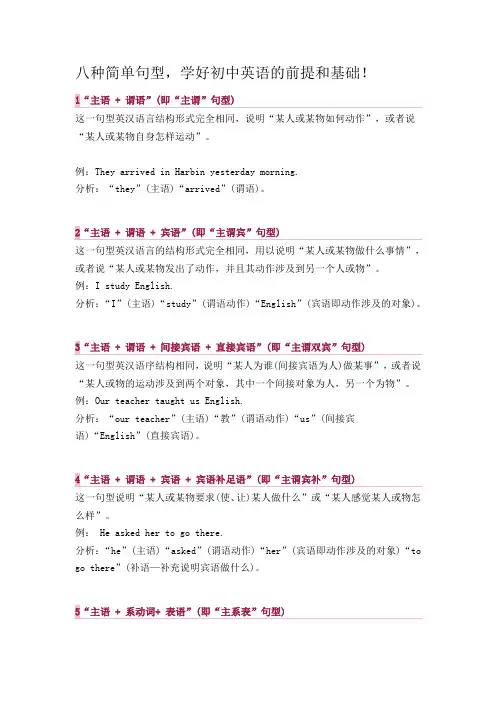
八种简单句型,学好初中英语的前提和基础!这一句型英汉语言结构形式完全相同,说明“某人或某物如何动作”,或者说“某人或某物自身怎样运动”。
例:They arrived in Harbin yesterday morning.分析:“they”(主语)“arrived”(谓语)。
这一句型英汉语言的结构形式完全相同,用以说明“某人或某物做什么事情”,或者说“某人或某物发出了动作,并且其动作涉及到另一个人或物”。
例:I study English.分析:“I”(主语)“study”(谓语动作)“English”(宾语即动作涉及的对象)。
这一句型英汉语序结构相同,说明“某人为谁(间接宾语为人)做某事”,或者说“某人或物的运动涉及到两个对象,其中一个间接对象为人,另一个为物”。
例:Our teacher taught us English.分析:“our teacher”(主语)“教”(谓语动作)“us”(间接宾语)“English”(直接宾语)。
这一句型说明“某人或某物要求(使、让)某人做什么”或“某人感觉某人或物怎么样”。
例: He asked her to go there.分析:“he”(主语)“asked”(谓语动作)“her”(宾语即动作涉及的对象)“to go there”(补语—补充说明宾语做什么)。
5“主语 + 系动词+ 表语”(即“主系表”句型)这一句型用以说明“某人(某物、某事、某种概念)具有什么特征或处于什么状态”。
汉语的“是”字结构属于这一英语句型的形式之一。
常用的联系动词有be, keep,lie, remain, stand, become, fall, get, go, grow, turn, look, feel, seem, smell, sound, taste, 等。
例: I am a teacher. 我是一名老师分析:“I”(主语)“am”(系动词)“a teacher”(表语—即表明主语的身份)。
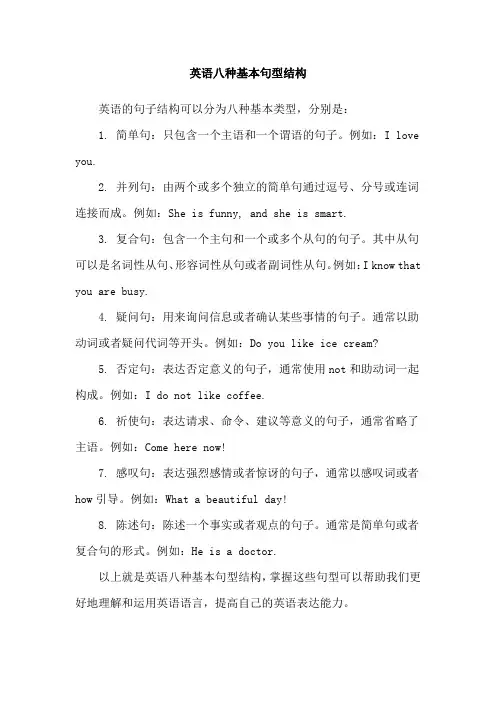
英语八种基本句型结构
英语的句子结构可以分为八种基本类型,分别是:
1. 简单句:只包含一个主语和一个谓语的句子。
例如:I love you.
2. 并列句:由两个或多个独立的简单句通过逗号、分号或连词连接而成。
例如:She is funny, and she is smart.
3. 复合句:包含一个主句和一个或多个从句的句子。
其中从句可以是名词性从句、形容词性从句或者副词性从句。
例如:I know that you are busy.
4. 疑问句:用来询问信息或者确认某些事情的句子。
通常以助动词或者疑问代词等开头。
例如:Do you like ice cream?
5. 否定句:表达否定意义的句子,通常使用not和助动词一起构成。
例如:I do not like coffee.
6. 祈使句:表达请求、命令、建议等意义的句子,通常省略了主语。
例如:Come here now!
7. 感叹句:表达强烈感情或者惊讶的句子,通常以感叹词或者how引导。
例如:What a beautiful day!
8. 陈述句:陈述一个事实或者观点的句子。
通常是简单句或者复合句的形式。
例如:He is a doctor.
以上就是英语八种基本句型结构,掌握这些句型可以帮助我们更好地理解和运用英语语言,提高自己的英语表达能力。
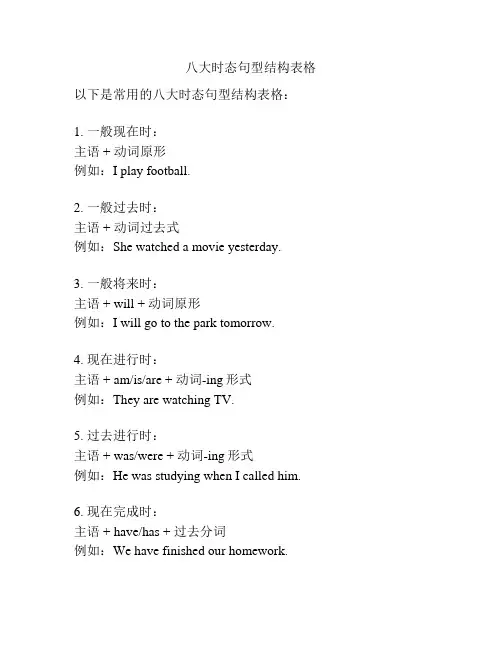
八大时态句型结构表格以下是常用的八大时态句型结构表格:
1. 一般现在时:
主语 + 动词原形
例如:I play football.
2. 一般过去时:
主语 + 动词过去式
例如:She watched a movie yesterday.
3. 一般将来时:
主语 + will + 动词原形
例如:I will go to the park tomorrow.
4. 现在进行时:
主语 + am/is/are + 动词-ing形式
例如:They are watching TV.
5. 过去进行时:
主语 + was/were + 动词-ing形式
例如:He was studying when I called him.
6. 现在完成时:
主语 + have/has + 过去分词
例如:We have finished our homework.
7. 过去完成时:
主语 + had + 过去分词
例如:She had already left when I arrived.
8. 将来完成时:
主语 + will have + 过去分词
例如:By the end of this week, I will have completed my project.
这些句型结构可以用于描述不同的时间和动作的关系,帮助表达不同的时态和语义。
注意,这只是一些常见的句型,实际运用时还需要根据具体语境来选择适当的时态。
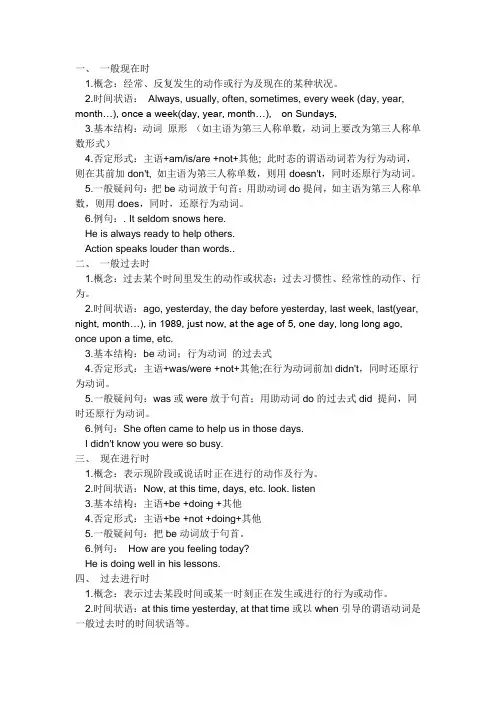
一、一般现在时1.概念:经常、反复发生的动作或行为及现在的某种状况。
2.时间状语:Always, usually, often, sometimes, every week (day, year, month…), once a week(day, year, month…), on Sundays,3.基本结构:动词原形(如主语为第三人称单数,动词上要改为第三人称单数形式)4.否定形式:主语+am/is/are +not+其他; 此时态的谓语动词若为行为动词,则在其前加don't, 如主语为第三人称单数,则用doesn't,同时还原行为动词。
5.一般疑问句:把be动词放于句首;用助动词do提问,如主语为第三人称单数,则用does,同时,还原行为动词。
6.例句:. It seldom snows here.He is always ready to help others.Action speaks louder than words..二、一般过去时1.概念:过去某个时间里发生的动作或状态;过去习惯性、经常性的动作、行为。
2.时间状语:ago, yesterday, the day before yesterday, last week, last(year, night, month…), in 1989, just now, at the age of 5, one day, long long ago, once upon a time, etc.3.基本结构:be动词;行为动词的过去式4.否定形式:主语+was/were +not+其他;在行为动词前加didn't,同时还原行为动词。
5.一般疑问句:was或were放于句首;用助动词do的过去式did 提问,同时还原行为动词。
6.例句:She often came to help us in those days.I didn't know you were so busy.三、现在进行时1.概念:表示现阶段或说话时正在进行的动作及行为。
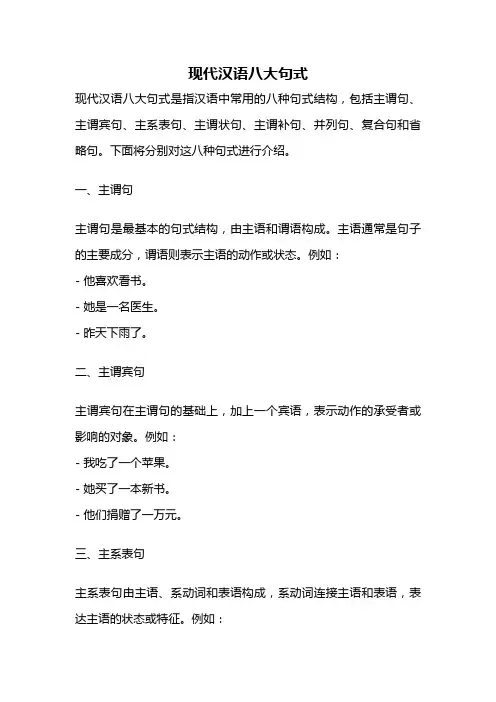
现代汉语八大句式现代汉语八大句式是指汉语中常用的八种句式结构,包括主谓句、主谓宾句、主系表句、主谓状句、主谓补句、并列句、复合句和省略句。
下面将分别对这八种句式进行介绍。
一、主谓句主谓句是最基本的句式结构,由主语和谓语构成。
主语通常是句子的主要成分,谓语则表示主语的动作或状态。
例如:- 他喜欢看书。
- 她是一名医生。
- 昨天下雨了。
二、主谓宾句主谓宾句在主谓句的基础上,加上一个宾语,表示动作的承受者或影响的对象。
例如:- 我吃了一个苹果。
- 她买了一本新书。
- 他们捐赠了一万元。
三、主系表句主系表句由主语、系动词和表语构成,系动词连接主语和表语,表达主语的状态或特征。
例如:- 她是个优秀的学生。
- 这个花园变得美丽起来。
- 孩子们都很开心。
四、主谓状句主谓状句在主谓句的基础上,加上一个状语,表示动作发生的时间、地点、方式等。
例如:- 我们明天去旅行。
- 他们在公园里散步。
- 她用手指着远处的山。
五、主谓补句主谓补句由主谓句加上一个补语构成,补语可以是名词、形容词、副词等,用来补充说明主语或谓语。
例如:- 我把书放在桌子上。
- 他们把问题解决了。
- 她把花种在花盆里。
六、并列句并列句由两个或多个主谓结构相互并列而成,表示并列的动作或状态。
例如:- 他喜欢唱歌,也喜欢跳舞。
- 我要去北京,也要去上海。
- 她又聪明又漂亮。
七、复合句复合句由一个主句和一个或多个从句构成,从句在句子中充当其他成分的角色。
例如:- 我希望明天天晴,我们可以出去玩。
- 他说他会来,但并没有兑现。
- 老师告诉我们要努力学习,才能取得好成绩。
八、省略句省略句是指在句子中省略了某些成分,但根据上下文可以推断出来。
例如:- 你吃饭了吗?(省略了主语"你")- 她去超市买东西,我去书店。
(省略了第二个主语"她")- 他跑得比我快。
(省略了"比较级"后面的"跑得")。
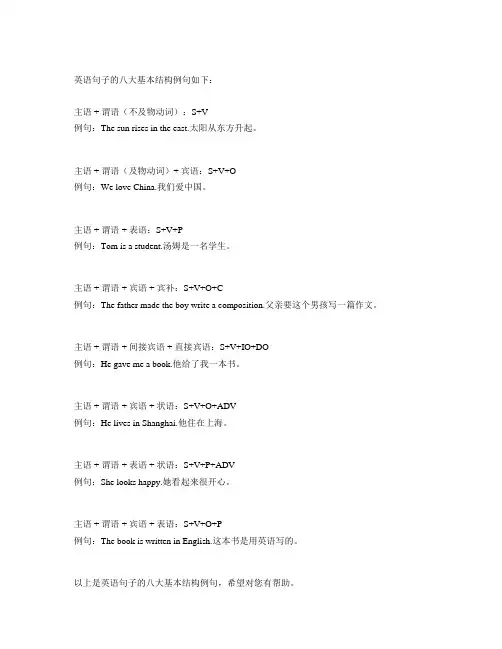
英语句子的八大基本结构例句如下:
主语 + 谓语(不及物动词):S+V
例句:The sun rises in the east.太阳从东方升起。
主语 + 谓语(及物动词)+ 宾语:S+V+O
例句:We love China.我们爱中国。
主语 + 谓语 + 表语:S+V+P
例句:Tom is a student.汤姆是一名学生。
主语 + 谓语 + 宾语 + 宾补:S+V+O+C
例句:The father made the boy write a composition.父亲要这个男孩写一篇作文。
主语 + 谓语 + 间接宾语 + 直接宾语:S+V+IO+DO
例句:He gave me a book.他给了我一本书。
主语 + 谓语 + 宾语 + 状语:S+V+O+ADV
例句:He lives in Shanghai.他住在上海。
主语 + 谓语 + 表语 + 状语:S+V+P+ADV
例句:She looks happy.她看起来很开心。
主语 + 谓语 + 宾语 + 表语:S+V+O+P
例句:The book is written in English.这本书是用英语写的。
以上是英语句子的八大基本结构例句,希望对您有帮助。
八大时态句型摘要:一、引言二、八大时态句型的概念1.一般现在时2.一般过去时3.一般将来时4.现在进行时5.过去进行时6.将来进行时7.现在完成时8.过去完成时三、各种时态句型的应用1.一般现在时的应用2.一般过去时的应用3.一般将来时的应用4.现在进行时的应用5.过去进行时的应用6.将来进行时的应用7.现在完成时的应用8.过去完成时的应用四、时态句型的转换1.一般现在时与一般过去时的转换2.一般将来时与一般过去时的转换3.现在进行时与过去进行时的转换4.将来进行时与过去进行时的转换5.现在完成时与过去完成时的转换五、结论正文:八大时态句型是英语语法中的重要内容,包括一般现在时、一般过去时、一般将来时、现在进行时、过去进行时、将来进行时、现在完成时和过去完成时。
这些时态句型不仅能够明确地表达动作或状态发生的时间,还能体现动作或状态的持续性、完成性等特点。
因此,掌握这些时态句型对于英语学习者来说至关重要。
一般现在时表示现在的习惯、事实或一般情况,如:“我每天早上起床。
”一般过去时表示过去某个特定时间发生的动作或存在的状态,如:“我昨天去了公园。
”一般将来时表示将来某个时间会发生的动作或存在的状态,如:“我将要去美国留学。
”现在进行时表示现在正在进行的动作或存在的状态,如:“我正在吃饭。
”过去进行时表示过去某个特定时间正在进行的动作或状态,如:“我昨天正在看电影。
”将来进行时表示将来某个特定时间将要进行的动作或状态,如:“我将来会去旅行。
”现在完成时表示过去发生的动作或状态对现在造成的影响,如:“我已经完成了作业。
”过去完成时表示过去某个时间点之前已经完成的动作或状态,如:“我昨天之前已经完成了所有工作。
”各种时态句型在实际应用中有着广泛的使用,例如:描述过去的事情、计划未来的活动、描述正在进行的动作等。
此外,各种时态句型之间也可以相互转换。
例如,一般过去时可以通过“was/were + 动词的过去分词”形式转换为一般现在时;一般将来时可以通过“will + 动词原形”转换为一般过去时等。
英语八大时态基本句型及例句英语中有八种基本时态,包括:现在简单时态、现在进行时态、现在完成时态、过去简单时态、过去进行时态、过去完成时态、将来简单时态和将来完成时态。
以下是每种时态的基本句型及例句:1. 现在简单时态(Present Simple Tense)基本句型:主语 + 动词原形(第三人称单数加s)例句:My sister reads books every day.(我姐姐每天都读书。
) 2. 现在进行时态(Present Continuous Tense)基本句型:主语 + am/is/are + 现在分词例句:I am studying English now.(我正在学英语。
)3. 现在完成时态(Present Perfect Tense)基本句型:主语 + have/has + 过去分词例句:She has visited many countries.(她去过很多国家。
) 4. 过去简单时态(Past Simple Tense)基本句型:主语 + 过去式动词例句:He went to the beach last weekend.(上周末他去了海滩。
)5. 过去进行时态(Past Continuous Tense)基本句型:主语 + was/were + 现在分词例句:They were playing basketball when it started to rain.(当下雨时他们正在打篮球。
)6. 过去完成时态(Past Perfect Tense)基本句型:主语 + had + 过去分词例句:I had finished my homework before my friends arrived.(朋友到达之前我已经完成了作业。
)7. 将来简单时态(Future Simple Tense)基本句型:主语 + will + 动词原形例句:I will help you with your project tomorrow.(我明天会帮你做项目。
八大修辞答题模板一、比喻修辞:比喻是指用一个事物来比拟另一个事物,以达到揭示事物本质、突出事物特点的修辞手法。
常用表达比喻的句型有:“A就是B”,“像A一样B”等。
比如:太阳像一个大火球,把大地照得金光闪闪。
二、拟人修辞:拟人是指把非人的事物赋予人的特点和行为的修辞手法,通过让事物具有思想、感情、行为等人的属性来增强表达的效果。
常用表达拟人的句型有:“XX想/以为/生气了”,“XX迈着坚定的步伐”等。
比如:树枝轻轻地摇曳着,好像在和风儿耳语。
三、排比修辞:排比是指在句子中重复使用同类成分,以增强表达的力度、统一感和节奏感的修辞手法。
常用表达排比的句型有:“A,B,C”,“既要A,又要B,还要C”等。
比如:她的眼睛像星星一样明亮,眉毛像两道彩虹,笑容像春风一样温暖。
四、夸张修辞:夸张是指对事物程度或规模进行夸大处理的修辞手法,通过放大表达来达到夸张效果。
常用表达夸张的句型有:“XX得要命”,“XX无比/极其”等。
比如:他的胃口大得像一个黑洞,简直能吞下整个世界。
五、反问修辞:反问是指用问句的形式来表达肯定或否定的修辞手法,通过让读者思考,引起共鸣和思考的效果。
常用表达反问的句型有:“难道……?”,“你难道不知道……?”等。
比如:这么好的机会你难道不想抓住吗?六、设问修辞:设问是指通过提出问题来引起读者思考、加强表达效果的修辞手法,常用表达设问的句型有:“XX是什么样的?”,“XX真的有用吗?”等。
比如:爱情是谁的错?亲情是谁的错?七、对偶修辞:对偶是指在句子中使用相对的词、短语或句子来表达平衡、对比的修辞手法,增加表达的力度和美感。
常用表达对偶的句型有:“不仅……还……”,“既有A,又有B”等。
比如:他既是好学生,又是个优秀运动员。
八、夹叙夹议修辞:夹叙夹议是指在叙述过程中插入评论、议论的修辞手法,通过对事物进行评价、解读来升华和强化表达效果。
常用表达夹叙夹议的句型有:“可是……”,“其实……”等。
八大时态句型【最新版】目录1.一般现在时2.一般过去时3.一般将来时4.现在进行时5.过去进行时6.将来进行时7.现在完成时8.过去完成时正文英语时态是描述动作或状态发生时间的方法,一共有八种基本时态,分别是:一般现在时、一般过去时、一般将来时、现在进行时、过去进行时、将来进行时、现在完成时和过去完成时。
下面我们逐一介绍这八种时态及其句型。
1.一般现在时:表示现在的习惯、事实或一般情况。
句型为:主语 + 动词(原形)+ 其他成分。
例如:I study English every day.(我每天学英语。
)2.一般过去时:表示过去某个特定时间发生的动作或存在的状态。
句型为:主语 + 动词(过去式)+ 其他成分。
例如:I studied English yesterday.(我昨天学英语了。
)3.一般将来时:表示将来某个时间会发生的动作或存在的状态。
句型为:主语 + 动词(将来式)+ 其他成分。
例如:I will study Englishtomorrow.(我明天会学英语。
)4.现在进行时:表示现在正在进行的动作。
句型为:主语 + 动词(现在分词形式)+ 其他成分。
例如:I am studying English now.(我现在正在学英语。
)5.过去进行时:表示过去某个特定时间正在进行的动作。
句型为:主语 + 动词(过去分词形式)+ 其他成分。
例如:I was studying English at 8 o"clock last night.(昨天晚上八点我正在学英语。
)6.将来进行时:表示将来某个特定时间将要进行的动作。
句型为:主语 + 动词(将来分词形式)+ 其他成分。
例如:I will be studying English at 8 o"clock tomorrow.(明天早上八点我将要学英语。
)7.现在完成时:表示过去发生的动作对现在造成的影响或结果。
句型为:主语 + 动词(现在分词形式)+ have/has + 过去分词。
八大常用句型一)原因1.A number of factors are accountable for this situation.A number of factors might contribute to (lead to )(account for ) the pheno menon(problem).2. The answer to this problem involves many factors.3. The phenomenon mainly stems from the fact that...4. The factors that contribute to this situation include...5. The change in rgely results from the fact that...6. We may blame ...,but the real causes are...7. Part of the explanations for it is that ...8.One of the most common factors (causes ) is that ...9.Another contributing factor (cause ) is ...10.Perhaps the primary factor is that …11.But the fundamental cause is that ...二)比较1.The advantage far outweigh the disadvantages.2.The advantages of A are much greater than those of B.3.A may be preferable to B, but A suffers from the disadvantages that...4.It is reasonable to maintain that ...but it would be foolish to claim th at...5.For all the disadvantages, it has its compensating advantages.6.Like anything else, it has its faults.7.A and B has several points in common.8.A bears some resemblances to B.9.However, the same is not applicable to B.10. A and B differ in several ways.11. Evidently, it has both negative and positive effects.12. People used to think ..., but things are different now.13. The same is true of B.14. Wondering as A is ,it has its drawbacks.15. It is true that A ... , but the chief faults (obvious defects )are ...三)批驳1)It is true that ..., but one vital point is being left out.2) There is a grain of truth in these statements, but they ignore a more im portant fact.3) Some people say ..., but it does not hold water.4) Many of us have been under the illusion that...5) A close examination would reveal how ridiculous the statement is.6) It makes no sense to argue for ...7) Too much stress placed on ... may lead to ...8) Such a statement mainly rests on the assumption that ...9) Contrary to what is widely accepted, I maintain that ...四)后果1. It may give rise to a host of problems.2. The immediate result it produces is ...3. It will exercise a profound influence upon...4. Its consequence can be so great that...五)举例1) A good case in point is ...2) As an illustration, we may take ...3) Such examples might be given easily.4) ...is often cited as an example.六)证明1) No one can deny the fact that ...2) The idea is hardly supported by facts.3) Unfortunately, none of the available data shows ...4) Recent studies indicate that ...5) There is sufficient evidence to show that ...6) According to statistics proved by ..., it can be seen that ...七)开篇1) Many nations have been faced with the problem of ...2) Recently the problem has been brought into focus.3) Recently the phenomenon has become a heated topic.4) Recently the issue has aroused great concern among ...5) Nowadays there is a growing concern over ...6) Never in our history has the idea that ... been so popular.7) Faced with ..., quite a few people argue that ...8) According to a recent survey, ...9) With the rapid development of ..., ...八)结尾1) From what has been discussed above, we can draw the conclusion that ...2) It is high time that strict measures were taken to stop ...3) It is necessary that steps should be taken to ...4) In conclusion, it is imperative that ...5) There is no easy method, but ...might be of some help.6) To solve the above-mentioned problem, we must ...7) In summary, if we continue to ignore the above-mentioned issue, more pr oblems will crop up.8) With the efforts of all parts concerned, the problem will be solved tho roughly.9) We might do more than identify the cause ; it is important to take acti ons to ...10) Taking all these into account, we ...11) Whether it is good or not /positive or negative, one thing is certain/ clear...14类常用短语1、学校生活及学习成绩Be getting on well with one’s study某人的学习越来越好take several courses at school在学校学若干门课程have English (Chinese, Physics…) every (other )day work hard at …put one’s heart into…专心于;致力于be interested in …be fond oflike chemistry bestbe good at …; be poor at …; do well in …; be weak in …make progress in …; fail in …’ be tired of …’pass the examination; give sb. a passing grade;major in history 主修历史He has the best record in school. 他的成绩最棒。
get a doctor’s degree 获得博士学位be more interesting to sb.learn about; succeed in…; be active in class (work);take an active part in …; learn… by heart;work out a (maths) problem; improve oneself in …;get 90 marks for (English); get an “A” in the exam;have a good command of…lay a good foundation in (language study)2、师生关系get on well with sb; like to be with students;be gentle with us; be kind to sb;be a strict teacher; be strict with one’s pupils;be strict in workWe think of him (her) as …; help sb with sth;praise sb for sth …; blame sb for sth..give advice on …; question sb on …be satisfied with …correct the students’ homework carefully and prepare for the next day; giv e sb a lot of work;try to teach sb good study habits; make one’s lessons lively and interesti ng; teach sb. sth.;teach sb to do sth.devote all one’s time to work;admire (sb.for) his devotion to the cause of education佩服他对于教育事业的献身精神。